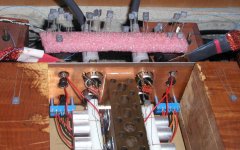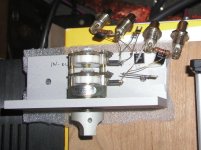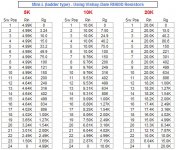I usually switch the sources by swapping cables, but sooner or later an input selector should be available as well.
I still like the feeling of old type approach, when a rotary switch is used and all sources wired directly. Rarely a remote convenience is needed for sources (unless one does listening comparison tests).
The control board (designed by Veteran, who is also a forum member) is universal and can handle sources switching. It's also good to control WM8816 chip.
PS: I forgot to mention, but the attenuator's calculator spreadsheed was prepared by Algar_emi.
I still like the feeling of old type approach, when a rotary switch is used and all sources wired directly. Rarely a remote convenience is needed for sources (unless one does listening comparison tests).
The control board (designed by Veteran, who is also a forum member) is universal and can handle sources switching. It's also good to control WM8816 chip.
PS: I forgot to mention, but the attenuator's calculator spreadsheed was prepared by Algar_emi.
An externally hosted image should be here but it was not working when we last tested it.
Peter,
The remote attenuator looks very promising! Please keep us updated on any developments.
Best,
KT
The remote attenuator looks very promising! Please keep us updated on any developments.
Best,
KT
hungrych said:How would this compare to something like a TVC?
I would say it's a matter of personal preference. I enjoyed TVC immensly few years back. Later, I switched to an active preamp (modified Levinson ML360S) as I found it was beter dynamically with my passive I/V output DAC.
Then I tried resistor based attenuator, and actually didn't like it much initially, active preamp was still better. But when I added output buffer to the DAC and changed my speakers for higher resolution units, the resistor attenuator appeared suddenly better than an active preamp. TVC was still fine, but sounded smoother with less bite, for my taste, almost too organic and mellow with some air missing.
Building good sounding attenuator is not an easy task, and the resistors choice is quite important. I've built mine with nude Vishays and Caddocks, and only then I got the signature that was appealing and involving, to me.
Attenuator kits...
Peter, your kit seems intriguing.
Have you checked out Ron Welborne's remote attenuator kit?
Nice as a complete package with case, but $500...
Welborne Zephyr Page
The raw kit stuff is pretty sweet, starting at $150...
Welborne Remote Kit Page
Any thoughts in comparing your approach to the Welborne unit?
-Rob
Peter, your kit seems intriguing.
Have you checked out Ron Welborne's remote attenuator kit?
Nice as a complete package with case, but $500...
Welborne Zephyr Page
An externally hosted image should be here but it was not working when we last tested it.
The raw kit stuff is pretty sweet, starting at $150...
Welborne Remote Kit Page
An externally hosted image should be here but it was not working when we last tested it.
An externally hosted image should be here but it was not working when we last tested it.
Any thoughts in comparing your approach to the Welborne unit?
-Rob
Choice of relay?
Hello Peter! I've been calculating (vs building !) on resistor attenuators for some time. One of my dilemmas is over the relative merits of a single series with multiple shunt resistors (one for each position), and whether multiple connections/contacts in the signal path are audibly detrimental.
I gather from your posting that the shunt portion of the attenuator can/will also affect the resulting sound, correct? Based on your listening, is the audible effect of a resistor the same in either shunt or series usage?
Do you have any opinion regarding the effect (if any) of multiple relay contacts in the signal path?
Is there a particular relay type/model which you have found to be preferable and/or have included in your PCB layout?
Lastly, I'm assuming that there is no relay coil drive circuitry on your board, true?
Looks like a great project! Thanks! - Ted
Hello Peter! I've been calculating (vs building !) on resistor attenuators for some time. One of my dilemmas is over the relative merits of a single series with multiple shunt resistors (one for each position), and whether multiple connections/contacts in the signal path are audibly detrimental.
I gather from your posting that the shunt portion of the attenuator can/will also affect the resulting sound, correct? Based on your listening, is the audible effect of a resistor the same in either shunt or series usage?
Do you have any opinion regarding the effect (if any) of multiple relay contacts in the signal path?
Is there a particular relay type/model which you have found to be preferable and/or have included in your PCB layout?
Lastly, I'm assuming that there is no relay coil drive circuitry on your board, true?
Looks like a great project! Thanks! - Ted
The shunt resistor will influence the sound in a same way as series resistor, at least that was my observation in my particular setup. That's why Welbourne approach may be compromised, although the whole package looks very nice.
If large control range and particularly small steps are not required, I believe that fixed series, variable shunt is the best approach to resistor attenuator. Preferrably, both series and shunt resistors should be of the same type, although in case of a GC, a Caddock MK132 works much better as shunt than all 3 types of Vishay I tried. For a series resistor I'm choosing nude Vishay, as it seems to be most neutral from off shelf available resistors (Percy carries them as well, although price is higher than directly from TC).
Similar approach has been also used in Pass X-0 preamp, although to extend range it's done in two stages..
I'm presentyl have such setup as well, although it is rather temporary. I don't have a switch for shunt adjustement, a simple socket where I insert resistors is used instead. So far I only needed 4 resistor to adjust gain comfortably ( for 10k series they were between 866R and 2k5 in parallel with 22k permanent resistor at amps input). I can replace resistors on a fly, without switching amp off, and kinda like that arrangement😉
If large control range and particularly small steps are not required, I believe that fixed series, variable shunt is the best approach to resistor attenuator. Preferrably, both series and shunt resistors should be of the same type, although in case of a GC, a Caddock MK132 works much better as shunt than all 3 types of Vishay I tried. For a series resistor I'm choosing nude Vishay, as it seems to be most neutral from off shelf available resistors (Percy carries them as well, although price is higher than directly from TC).
Similar approach has been also used in Pass X-0 preamp, although to extend range it's done in two stages..
I'm presentyl have such setup as well, although it is rather temporary. I don't have a switch for shunt adjustement, a simple socket where I insert resistors is used instead. So far I only needed 4 resistor to adjust gain comfortably ( for 10k series they were between 866R and 2k5 in parallel with 22k permanent resistor at amps input). I can replace resistors on a fly, without switching amp off, and kinda like that arrangement😉
Attachments
Comparing that approach (which is the ultimate purity I can imagine), to Placette that uses relays for switching both series and shunt reistors, I don't really hear much difference. I am also surprised that Placette performs that well. It seems that tere is some "white noise haze" (I can't really find a better desription, it's definitely not dull or laid back, it's rather overly airy, the airyness I couldn't really easily duplicate) and slight brightness (comparing to my setup), but it so insignificant that I wouldn't loose sleep over that.
There is a lot of work put into implementing the circuitry inside Placette, with p2p wiring and mechanical decoupling. That unit is certainly worth $1000 asking price, and getting used one at $600 is definitely a bargain. However, the system matching is required, some sources may not work optimally woth passive attenuator, as well it's preferable to insert Placette very close to the amp.
You can find Placette in the best systems, here are two fine examples:
http://aca.gr/pop_lavigne.htm
http://www.goodsoundclub.com/Forums/ShowPost.aspx?postID=957#957
There is a lot of work put into implementing the circuitry inside Placette, with p2p wiring and mechanical decoupling. That unit is certainly worth $1000 asking price, and getting used one at $600 is definitely a bargain. However, the system matching is required, some sources may not work optimally woth passive attenuator, as well it's preferable to insert Placette very close to the amp.
An externally hosted image should be here but it was not working when we last tested it.
You can find Placette in the best systems, here are two fine examples:
http://aca.gr/pop_lavigne.htm
http://www.goodsoundclub.com/Forums/ShowPost.aspx?postID=957#957
I found out how improtant is the proper choice of resistors in building top notch attenuator by my first approach to improve on Placette. I used a fixed series Caddosck TF020 and DACT switch for shunt adjustement. That could have seem like seemingly better approach, as series element was fixed and didn't change (no switching in direct signal path), however, that circuit did not compare to Placette that was actually much preferred. I later changed series resistor for a Vishay, but still, it didn't improve things much. I can only presume that DACT was there to blame. 😉
Attachments
I investigated few relays, with regards to switching noise, internal build and actual performance in a circuit, and decided to use Nais (PAnasonic) TQ2 form Digi Key: http://rocky.digikey.com/WebLib/Aromat/Web Data/TQ Series.pdf
That relay seem to be pretty popular with attenuator builders, including this person here: http://jos.vaneijndhoven.net/switchr/index.html and Placette as well.
That relay seem to be pretty popular with attenuator builders, including this person here: http://jos.vaneijndhoven.net/switchr/index.html and Placette as well.
Attachments
Both control and relays boards layouts have been finalized and sent for fabrication. It all comes down to programming now, and this is beyond my control as someone else is working on it. 😉
True Ladder attenuator arrangement is simpler as a circuit and almost invariably sounds better even than a shunt which is essentially a 'short cut' to emulate a ladder without the space., labour and parts requirements.
Bare said:True Ladder attenuator arrangement is simpler as a circuit and almost invariably sounds better even than a shunt which is essentially a 'short cut' to emulate a ladder without the space., labour and parts requirements.
Why is it simpler and sounds better?
Bare,
Isn't a true ladder attenuator twice as complex a standard attenuator but the benefits are constant impedence across the attenuation range?
Jam
Isn't a true ladder attenuator twice as complex a standard attenuator but the benefits are constant impedence across the attenuation range?
Jam
Peter Daniel said:...But when I added output buffer to the DAC and changed my speakers for higher resolution units, the resistor attenuator appeared suddenly better than an active preamp. TVC was still fine, but sounded smoother with less bite, for my taste, almost too organic and mellow with some air missing....
Peter,
How about buffer unit before the TVC? How does that compare to the buffer before the resistor attenuator?
Does the buffer give some drive and bite to the TVC sound that it was missing?
Best,
KT
When comparing shunt and true ladder attenuators, one can notice that the shunt attenuator moves away from constant impedance only at certain volume settings, setings which usually are not being used anyway (with reasonable error margin of course).
Below is the table posted on DACT site for true ladder attnuator resistor values. Let's have a look at 10K attenuator. As we can see, the series resistor value starts to change significanlty with pos 19 (where the difference is more than 20% for -12db setting).
In my particular setup, I never set the volume higher than -12dB position, with -16dB being usual loud setting.
Now, why on Earth, should I go with true ladder arrangement, employing 15 almost same value resistors (at $10 ea.) and adding a series switch? I couldn't care less if total impedance is 10k or 12.5k.
How can it be simpler, not to mention sounding better?
Below is the table posted on DACT site for true ladder attnuator resistor values. Let's have a look at 10K attenuator. As we can see, the series resistor value starts to change significanlty with pos 19 (where the difference is more than 20% for -12db setting).
In my particular setup, I never set the volume higher than -12dB position, with -16dB being usual loud setting.
Now, why on Earth, should I go with true ladder arrangement, employing 15 almost same value resistors (at $10 ea.) and adding a series switch? I couldn't care less if total impedance is 10k or 12.5k.
How can it be simpler, not to mention sounding better?
Attachments
- Status
- Not open for further replies.
- Home
- Amplifiers
- Chip Amps
- In search of a perfect attenuator




